While writing the 2022-23 Regular Season Awards article, I found that the issues surrounding the Rookie of the Year race clearly required a deeper dive into the data. As I wanted to keep the Awards article brief (you’re welcome), this article was created.
What can the Statistics Say?
Statistics can be used several ways, depending on what you want them to show. I try to use statistics as a sober person uses a streetlight: for illumination. When you ask the data appropriate questions, you get appropriate answers.
Sports writers tend to use statistics as a drunk person uses a streetlight: for support. They will start with their opinion and scrounge for data that supports their opinion. Or they just get on their soapbox and repeat their opinions, because if you say something often enough it has got to be true.
Not being a sportswriter, I asked the data a question: who was the Rookie of the Year? More specifically, I asked the data: which rookie had the best season?
This didn’t require a lot of work on my part, as I already have a statistic which evaluates each player’s season: Productivity Rating (PR). All I then had to do was identify the rookies (NaturalStatTrick.com has some reports which allow one to identify the rookies), sort them by PR-Score, and see who ended up on the top of the list.
Sports Writers (and Radio Announcers) can Sometimes be Correct
My apologies to the announcers at TSN 1200, Ottawa’s best radio station, for lumping them in with sportswriters. Several of them have said that The Rookie of the Year award should go to Jake Sanderson (OTT). While they may have been preaching to the converted, the statistics supported their statement.
The depressing part is that they are almost certainly correct in their extended statement: that Sanderson will not win the award. It is believed it will go to either Matty Beniers (SEA) or Owen Power (BUF).
The top four rookies according to PR all rated as PR-First5, meaning their PR-Scores were between 6.00 and 7.99. They were Sanderson (PR-Sc0re=7.60), Owen Power (7.17), Noah Cates (PHI, 6.65) and Matty Beniers (6.50).
I will start by going deeper into the data for Sanderson and Power, the two best rookies who also happen to both be defensemen. And to do that, I will use the Dashboard.
Dashboard
I have a chart called the Dashboard. It shows where a player stands in various statistical categories with respect to all other players in the league in a season. The field is limited to players who had at least 820 minutes of ice time during the season. I’ll use an anti-rookie to explain the chart in some detail. Mark Giordano (TOR) started his career when this season’s rookies were either in diapers or yet to be born.
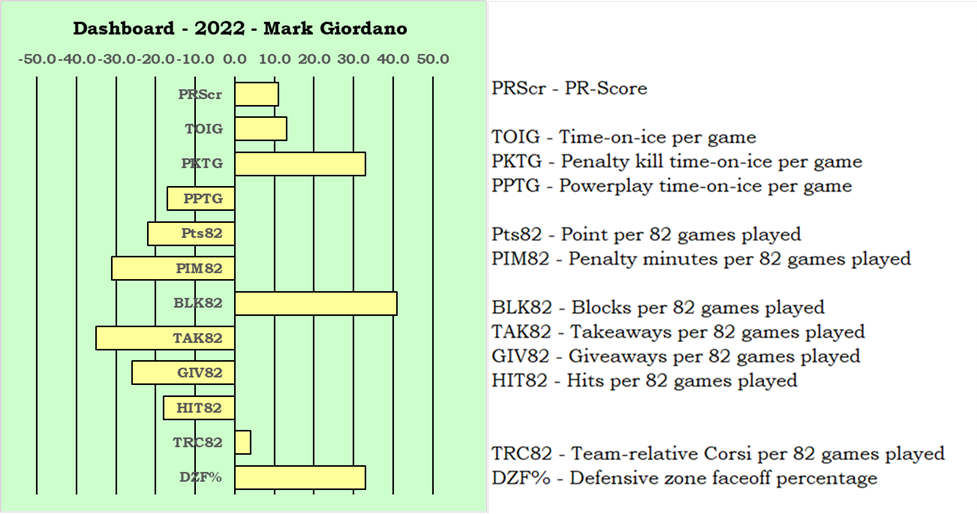
The dashboard bars radiate out from the centre, which represents the 50th percentile in each category. When a player is better than average in a category, the bar will go to the right; when he is below average in a category, the bar will go to the left. The farther out the bar goes, the farther away the player is from the mid-point.
In the PIM82 and GIV82 categories, being “better than average” means being below average numerically. It is better to take fewer penalties and have fewer giveaways.
What does the chart tell us about Giordano? He’s above the average PR-Score (in the 61st percentile), above average in time-on-ice and penalty kill time, and below average in powerplay time.
He’s below average in points but he is a defenseman, and the field includes forwards. He’s in the 80th percentile in terms of penalty minutes, so the bar radiates to the left because it’s not good to take penalties.
Giordano blocks a lot of shots, has few takeaways but too many giveaways and is a little below average in terms of hits delivered. He is very slightly above average in terms of team relative Corsi and is heavily used for defensive zone faceoffs.
Giordano’s chart shows what type of player he was in 2022-23: he provided little in the way of offense and was relied upon to play defense.
Sanderson vs. Power
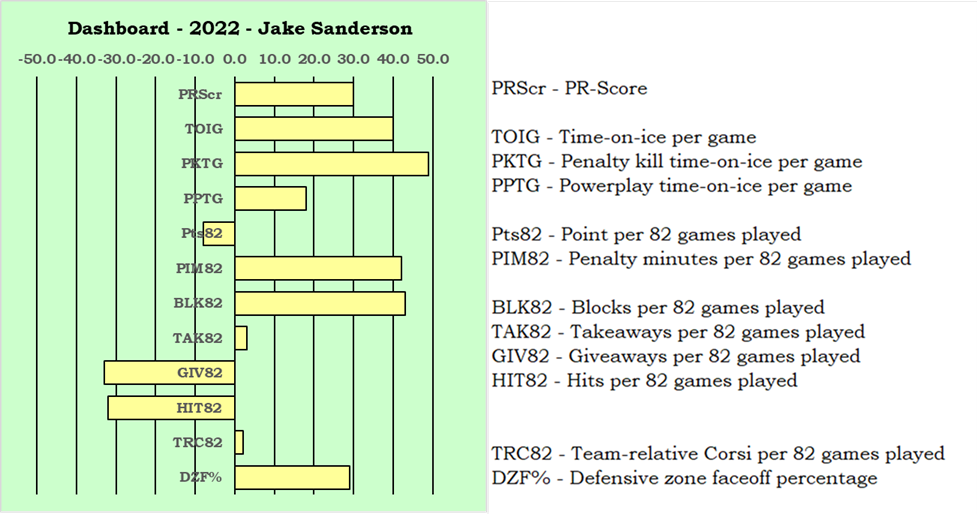
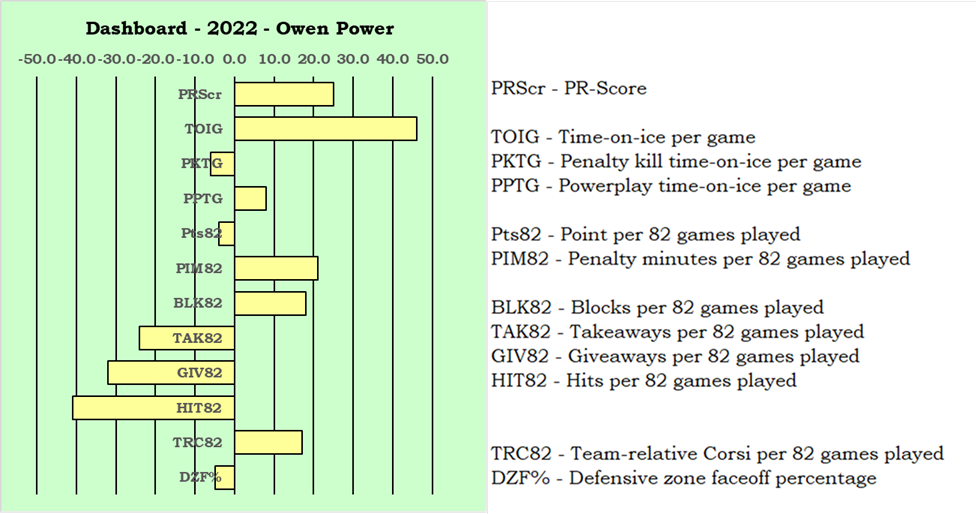
Power had more total ice time in a game, but Sanderson had more powerplay and penalty kill time.
Sanderson had more takeaways and delivered more hits. Power had a better team relative Corsi, while Sanderson started more often in the defensive zone. Those two factors are related: the more defensive zone starts one has, the worse his team relative Corsi will be.
Combining the time-on-ice and zone start data allows us to make an inference about these players. Sanderson was counted on to play in defensive situations in Ottawa, while Power was not the first choice for defense in Buffalo. Ottawa found reasons to put Sanderson on the ice, while Buffalo found reasons to keep Power on the bench.
To me, it is clear: Sanderson had a better season than Power.
Cates vs. Beniers
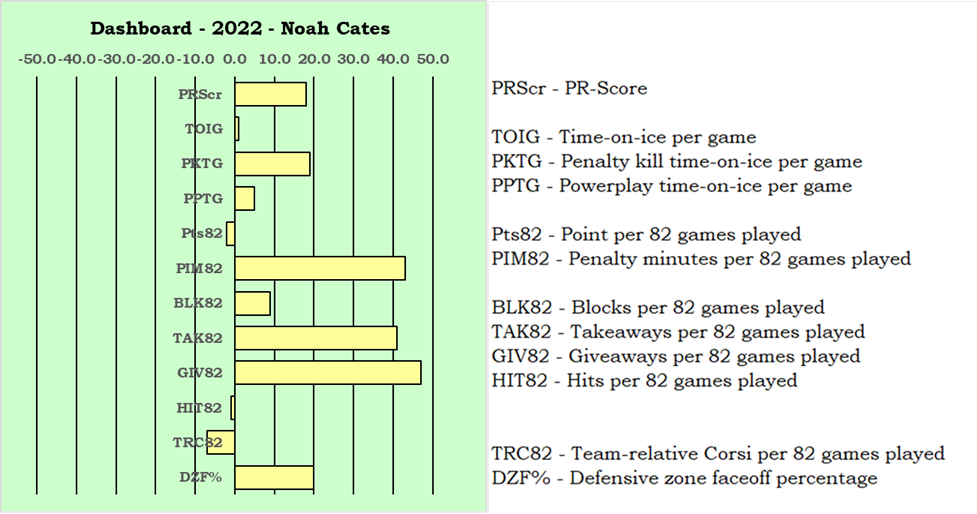
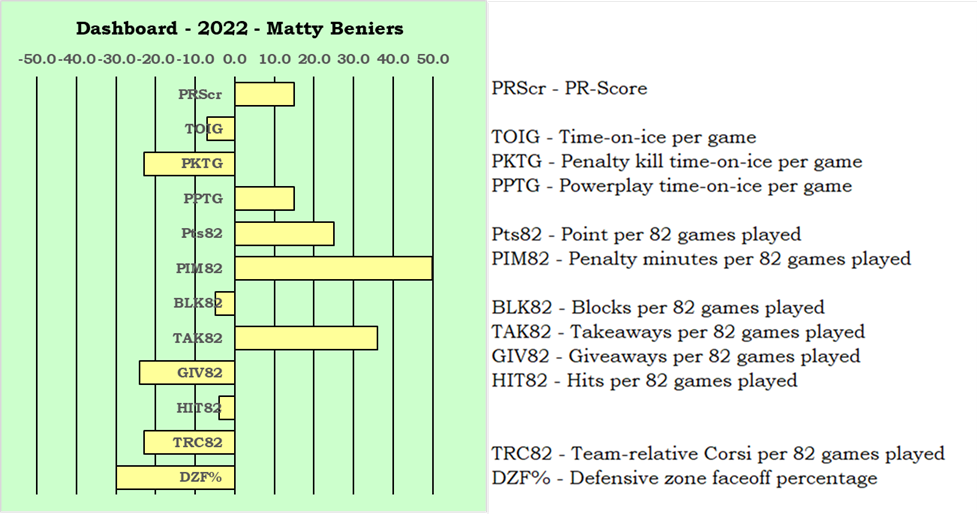
Numbers 3 and 4 on my list of rookies are both forwards. Cates had more ice-time per game and more penalty kill time. Beniers had more powerplay time, but not first unit powerplay time. Beniers had more points, probably as a result of the powerplay time.
Cates had an edge in blocked shots while Beniers had more giveaways.
Beniers had a lower team-relative Corsi and was seldom used for defensive zone starts. Cates was more frequently used for defensive zone starts and had a higher TRC82. It is not a good sign for Beniers that he had more offensive zone starts than Cates but had a worse team-relative Corsi.
I don’t know how you could look at this set of statistics and say that Beniers was better than Cates. And neither of them was better than either of Power or Sanderson.
Summary
Why would a person who has a Rookie of the Year vote select Beniers as their top candidate?
Because Beniers has been getting a lot of publicity since the start of the year.
Because Beniers scored more than 20 goals, and that is an impressive total for a rookie.
And bEcAuSe ThE kRaKeN mAdE tHe PlAyOfFs.
My responses to those reasons are: that what a player does on the ice is more important than his press coverage; that if you are a forward that gets powerplay time and does not play in defensive situations you damn well better score 20 goals; that his team making the playoffs had little to do with his contributions.
The data shows us that Sanderson was given significant defensive responsibility for a player so young, and that he was used in several roles. Beniers and Power were used in fewer situations.
The Rookie of the Year award should be awarded on the basis of a player’s accomplishments, rather than the accomplishments of his teammates. In 2022-23, Sanderson should be the Rookie of the Year.
Reference Articles
